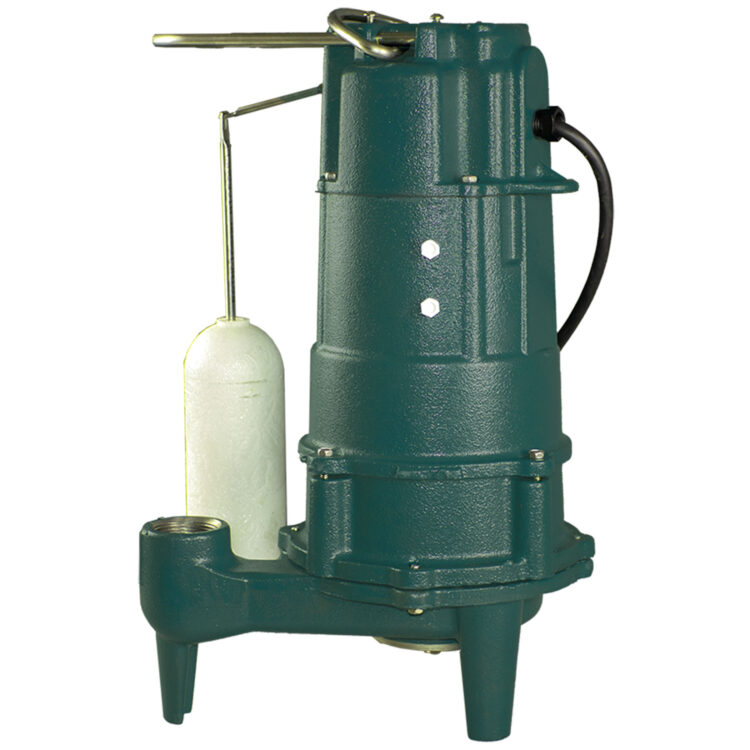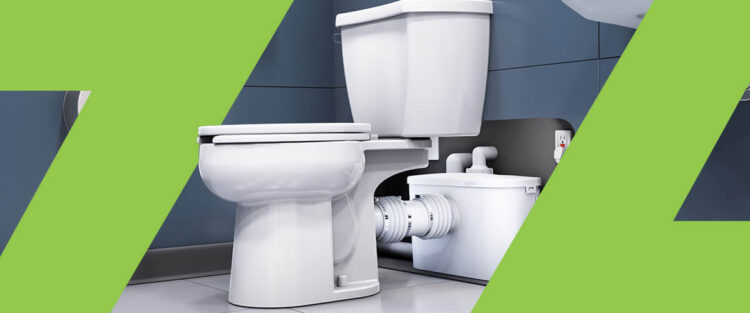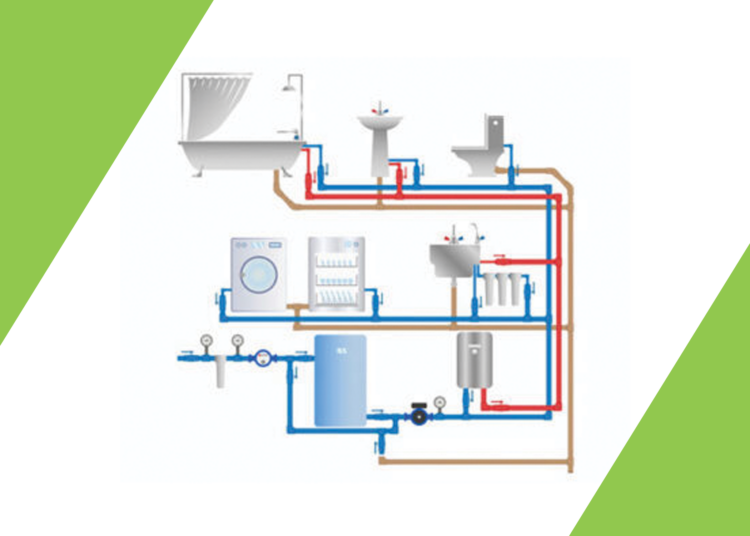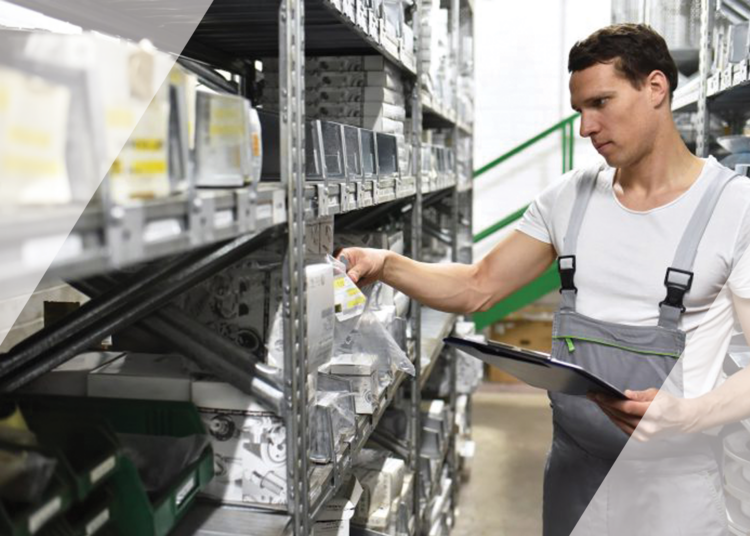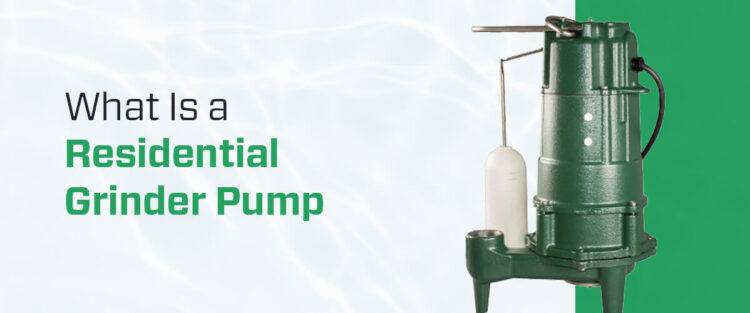
Residential grinder pumps are important because they move wastewater for homes located far from or below the main sewer line. Since wastewater cannot use gravity to move upward, it needs a boost to reach the main sewer line so it can eventually move on to a wastewater treatment facility. A residential grinder pump pulverizes solid waste material and uses pressure to force the water upward.
Understanding how a residential grinder pump works, what its purpose is and why it’s important can help you determine when to offer one to a client. In some areas, residential grinder pumps are crucial to proper wastewater handling. Installing residential grinder pumps in homes provides your clients with reliable systems they can trust.
What Is a Residential Grinder Pump?
A residential grinder pump is a pump that grinds solid sewage materials and pushes wastewater toward the main sewer line. Residential sewer grinder pumps move wastewater when gravity lines are not sufficient. Most wastewater flows downhill from residential homes located above the main sewer line. When homes are above the public main line, gravity can move wastewater from residential internal plumbing to the sewer.
Some residential homes are located below the main sewer line, requiring wastewater to move upward from the home’s internal plumbing to the main sewer. A residential grinder pump grinds wastewater and forces it upward to the main sewer line.
How Do Residential Grinder Pumps Work?
Residential grinder pumps sit in tanks buried underground outside residential properties. A residential grinder pump tank collects wastewater when it flows from a home’s internal plumbing. When the tank’s wastewater level reaches the tank’s capacity, the pump’s float automatically activates the pump so it operates to grind solid waste. The grinder pump then uses a pressure discharge line to pump the wastewater to the main sewer line.
Is a Residential Grinder Pump the Same as a Sewage Lift Pump?
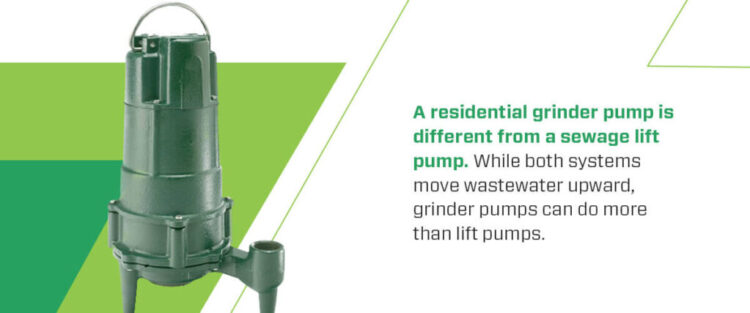
A residential grinder pump is different from a sewage lift pump. While both systems move wastewater upward, grinder pumps can do more than lift pumps.
Each sewage grinder pump contains a cutting mechanism to process solids effectively. Sewage lift pumps lack this mechanism, so they cannot process harder solids. Additionally, residential grinder pumps are more powerful than lift pumps, letting them move wastewater to higher points.
What Is the Difference Between Residential Grinder Pumps and Sewage Ejector Pumps?
Sewage grinder pumps and sewage ejector pumps use pressure to move wastewater and can handle solid materials. However, ejector pumps lack grinding blades and instead use rotating impellers to move the solid waste rapidly. Grinder pumps move wastewater slower than ejector pumps, but they can move wastewater to greater heights and over longer distances.
Residential grinder pumps contain grinding blades that turn solid waste into a slurry before pushing wastewater to the main sewer line. Ejector pumps can handle small solid materials, while grinder pumps can handle larger ones. Grinder pumps can also support more pressure at sewer mains than sewage ejector pumps. Ejector pumps can handle high wastewater volumes, but sewage grinder pumps can move wastewater from homes located far from the public sewer line.
Why Are Residential Grinder Pumps Important?
Residential grinder pumps are important for homes below the sewer line because they move wastewater that plumbing would otherwise leave behind if it relied on gravity alone. Without residential grinder pumps, families in these homes would experience clogged sinks and toilets along with unpleasant odors. If a residential property already has a grinder pump and still experiences unpleasant odors and clogging, it may need a new grinder pump with a higher horsepower (HP).
Proper wastewater collection and treatment are crucial to public health and safety. Wastewater collection and treatment ensure communities have access to clean water, and residential grinder pumps help wastewater reach treatment facilities. Installing grinder pumps in homes below the sewer line is also important for surrounding areas because these pumps prevent wastewater from spilling into communities.
Which Homes Need Residential Grinder Pumps?
Some homes can rely on gravity to move their wastewater, so not every property needs a residential grinder pump. A sewage ejector pump may be an adequate choice for a home pumping wastewater to a gravity-flow sewer main or a septic tank, but a residential grinder pump is an ideal option for homes pumping wastewater to a pressurized sewer main.
To determine if a home needs a grinder pump, you must consider its location, destination, and how much sewage you expect the system to pump. A residential property needs a grinder pump if it is located in any of the following areas:
A Community With a Pressure Sewer System
Traditional wastewater collection systems use buried piping structures to transport sewage from homes to treatment facilities. These systems can reliably transport wastewater using gravity flow. They do not require power, but they do require sufficient slopes to maintain adequate gravity flow. To achieve the right amount of gravity, some areas with flat or hilly terrain require deep excavations, sewage pump stations and maintenance holes.
Deep excavations and sewer accessories can become expensive to install and maintain, forcing some areas and communities to utilize pressure sewer systems. Pressure sewer systems are common in suburban neighborhoods and sparsely populated areas. A pressure sewer system typically consists of narrow pipes that move water at a slight slope or run along the land’s surface contour, which reduces construction and excavation costs.
Pressure sewer systems are also common in areas that have high groundwater because groundwater can flow into conventional sewer systems and increase the volume of wastewater that needs treatment. Pressure sewer systems are watertight, preventing wastewater from entering groundwater sources. Residents in communities with pressure sewer systems use grinder pumps to send their wastewater through the system.
Below the Sewer Line
Some homes are located below the public sewer line and require a grinder pump to send wastewater to the main system’s pipes. A grinder pump sends the wastewater upward since it cannot rely on gravity.
You can contact your local city office to find out where the public sewer line is located in relation to a new or existing home. Online underground utility maps can also reveal main sewer line locations.
Some homes are not below the main sewer line but are far enough away from it or parallel to it. When a house is too far from the main sewer line, wastewater cannot reach the treatment plant. A grinder pump gives wastewater the boost it needs to reach the public sewer system.
Parts of a Residential Grinder Pump
Each part of a residential grinder pump is crucial to proper operation. Residential grinder pumps could consist of the following parts:
- Sewage grinder tank
- Sewage pump tank vent
- Grinder pump system electrical disconnect box
- Pump alarm and grinder pump electrical wiring leads
- Lifting eyes on the mid-tank seam to remove the assembly
- Drain inlet
- Ground sewage outlet
- Drain inlet gravity service line
- Pumping tank anchor
- Pumping tank bedding gravel
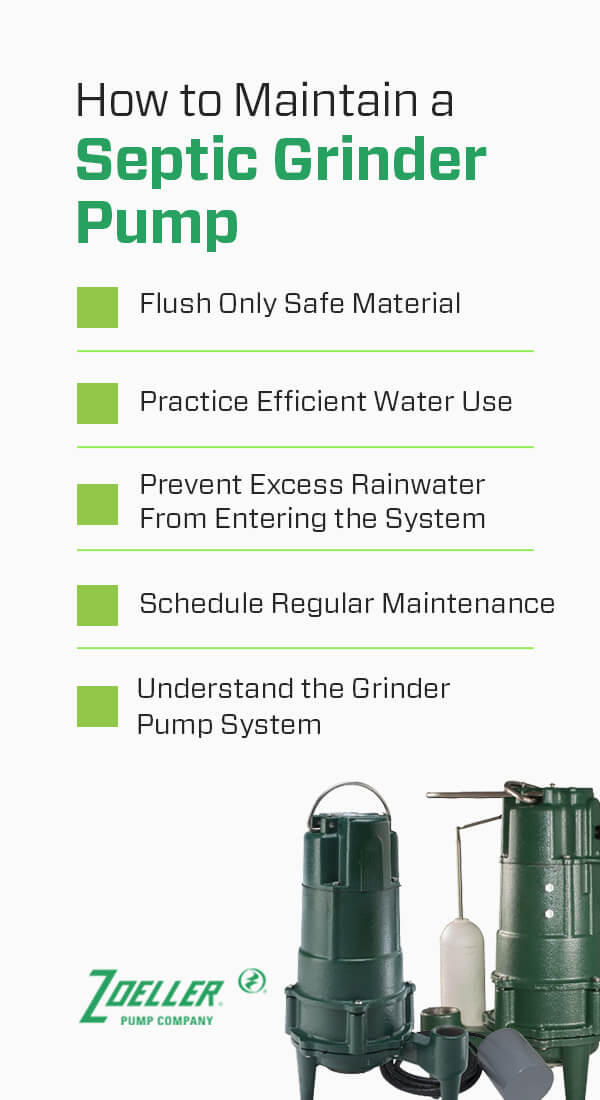
How to Maintain a Septic Grinder Pump
Proper installation ensures a residential property has a working grinder pump. However, residents must properly maintain the grinder pump to ensure it continues to operate effectively and reaches its expected life span. Each time you install a residential grinder pump, carefully explain to homeowners how to care for it and extend its life span with the following tips:
Flush Only Safe Material
A sewage grinder pump is not a garbage disposal, and it is only designed to handle human waste. Remind homeowners to allow only safe material to enter their grinder pumps. They should only flush human waste and toilet paper to prevent the grinder pump from overworking or becoming damaged. Make sure homeowners understand they must avoid flushing the following materials and substances:
- Wipes
- Cotton swabs
- Dental floss
- Diapers
- Condoms
- Feminine hygiene products
- Coffee grounds
- Cigarette butts
- Cat litter
- Fats, oils, grease and grit (FOGG)
- Any item that could clog the system
- Gasoline
- Household chemicals
- Paint
- Antifreeze
- Pesticides
Practice Efficient Water Use
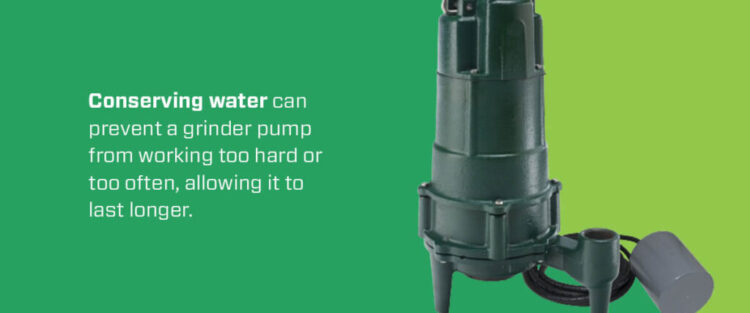
The less water a family uses, the less water a grinder pump receives. Conserving water can prevent a grinder pump from working too hard or too often, allowing it to last longer. Households can use water efficiently by turning faucets off when they are not using them and fixing leaks and drips when needed.
Prevent Excess Rainwater From Entering the System
Make sure excess rainwater cannot enter the grinder pump’s basin from nearby storm drains. Excess water increases pumping costs and frequency, depletes the basin’s available water capacity, and increases the volume of water entering wastewater treatment plants.
Keeping excess water out of a grinder pump’s system saves money and helps to prolong the pump’s life span. Encourage homeowners to contact a professional for assistance if they notice excess water entering their grinder pump.
Schedule Regular Maintenance
Regular maintenance is also important to prolonging a grinder pump’s life span. Homeowners should schedule annual inspections and have their pumps repaired when necessary. It’s also a homeowner’s responsibility to maintain their home’s plumbing. A well-maintained residential grinder pump could last up to 25 years, depending on the model and how often it’s inspected by a professional. After a pump has exhausted its life span, a homeowner should invest in a new one to prevent damage and sewage backup.
Understand the Grinder Pump System
Give homeowners the knowledge and confidence to maintain their grinder pump systems. After installing a grinder pump, you should provide useful information to help homeowners understand their grinder pump system. Show them where their service panels and circuit breakers are, and make sure they understand to avoid tampering with them so the system doesn’t shut down.
It’s also important to tell homeowners what to do in the event of a power outage. A grinder pump needs electricity to operate, so homeowners should be mindful of their pump’s capacity if a power outage occurs. They should avoid washing clothes and showering until their power returns and their pump is in operation. This will prevent the pump from backing up or spilling.
Homeowners should also conserve water if they experience a grinder pump failure. If their pump alarm sounds, they should schedule repairs as soon as possible and limit water usage in the meantime.
Zoeller Pump Company’s Residential Grinder Pumps
If you are installing a residential grinder pump or a replacement sewage pump for a client, ensure you provide them with a top-quality system. With a reliable grinder pump, homeowners can trust that their sewage is moving efficiently from their home to a wastewater treatment facility.
Zoeller Pump Company manufactures high-quality grinder pumps to move wastewater safely and efficiently. Our Shark series residential grinder pumps can handle and move flushable materials for entire households, making them a reliable choice for any homeowner. This reliable grinder pump series comes in three horsepower capacities, so you can choose the power output that best matches each client’s needs. You can provide your clients with the Shark 803, 805, or 807 grinder pump design.
Shark series grinder pumps can move wastewater over substantial distances of up to 55 feet, delivering reliable results and maximizing user flexibility. A Shark grinder pump is an affordable option that provides homeowners with an incredible return on investment. It is manufactured with a stainless steel plate and cutter, which effectively protects the pump from corrosion and allows it to cut through tough materials. The Shark grinder pump’s design also features three different cutting channels, allowing it to deliver 250,000 cuts per minute.

Provide Your Clients With Reliable Residential Grinder Pumps
Residential grinder pumps are incredibly important for homes located below the main sewer line. A residential grinder pump uses pressure to force wastewater upward toward the main sewer when gravity is not sufficient, preventing residential plumbing from clogging or overflowing.
Sewage grinder pumps are crucial for homes located below or far from a city’s main sewer line. If a client’s property is located too from or below the main sewer line, their house requires a residential grinder pump to adequately move wastewater. Offering high-quality residential grinder pumps for your clients’ homes provides them with reliable wastewater solutions, increasing their trust in your services and offerings.
Provide your clients with reliable residential grinder pumps from Zoeller Pump Company. Since 1939, Zoeller Pump has been an innovator and leader in the wastewater management industry. Our products are factory-tested to ensure top performance and minimal mechanical failures for unmatched reliability.
When you provide your clients with Shark series residential grinder pumps, you can expect one-of-a-kind performance. Our pumps feature patented technology exclusive to Zoeller Pump products, so your clients can have peace of mind that their system will operate efficiently for years to come. Locate a Zoeller Pump distributor to learn more about our residential grinder pumps and how we can help you provide your clients with reliable solutions.

